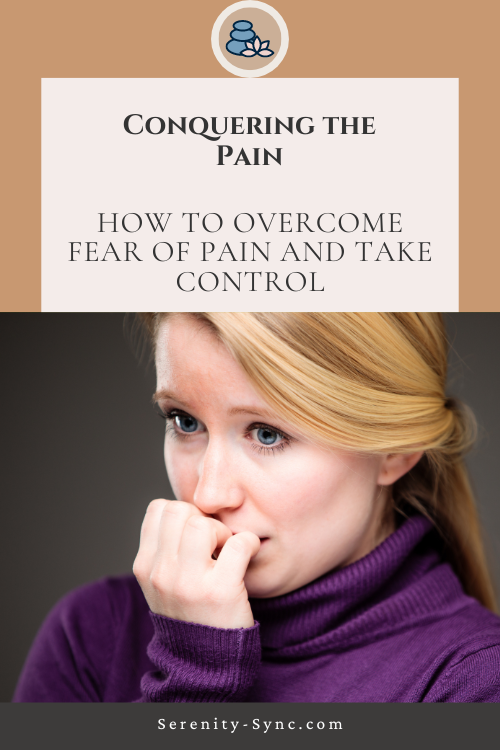In Brief
In this blog post, we will delve into the fear of pain and how it can impact our lives. We’ll explore the connection between fear, anxiety, and the perception of pain, as well as the cycle of avoidance behaviors that can worsen the situation. Discover how confronting your fear of pain is the key to breaking this cycle and gaining control over your physical and emotional well-being. With practical tips and strategies, we’ll show you how to manage fear and reduce pain, allowing you to regain your freedom and live life to the fullest.

Your Free PDF version of this blog post Awaits – No Strings, Just Click and Enjoy! 🌸🎁![]()
The Impact of Fear on Pain Perception
Fear of pain can have a significant impact on how we perceive and experience pain. When we are fearful, our brains become more sensitive to pain signals, amplifying the sensations we feel. This heightened perception of pain can make even minor discomfort feel unbearable.
Moreover, fear and anxiety can create a vicious cycle that perpetuates the pain experience. As we become more afraid of pain, our anxiety levels rise, leading to increased sensitivity to pain. This heightened sensitivity then reinforces our fear and anxiety, creating a feedback loop that can be difficult to break.
It’s important to recognize that avoiding pain-inducing activities can actually worsen our pain perception. When we avoid certain movements or activities out of fear, we inadvertently reinforce the idea that these activities are dangerous or painful. This avoidance behavior can lead to physical deconditioning, further exacerbating our pain and limiting our overall quality of life.
To break this cycle, it is essential to confront and manage our fear of pain. By gradually exposing ourselves to the activities that we fear, we can desensitize our brains and reduce our fear response. This can be done with the help of a healthcare professional or through self-directed methods such as gradual exposure therapy.
Fun Fact
Some studies suggest that individuals who have a higher pain tolerance tend to have a better sense of humor. So, the next time you’re feeling fearful or in pain, try cracking a joke or watching a funny movie to lighten the mood and ease the discomfort. Laughter truly is the best medicine!
Understanding the Fear-Avoidance Cycle
The fear-avoidance cycle is a pattern of behavior that occurs when we let our fear of pain dictate our actions. When we are afraid of experiencing pain, we may avoid activities that we associate with pain, discomfort, or potential injury. This avoidance behavior may provide temporary relief from our fear, but it ultimately reinforces our belief that these activities are dangerous or harmful.
However, avoiding pain-related activities can have detrimental effects on our emotional well-being. It can lead to feelings of frustration, helplessness, and decreased self-esteem. Additionally, avoiding physical activity can result in physical deconditioning, making us more prone to pain and injury in the long run.
To break free from the fear-avoidance cycle, gradual exposure and desensitization techniques are crucial. By gradually reintroducing the activities we have been avoiding, we can build our resilience and adaptability to pain. This process may involve working with a healthcare professional who can provide guidance and support throughout the journey.
Overcoming Fear: Techniques and Approaches
There are various techniques and approaches that can help us overcome our fear of pain and regain control over our lives. One powerful tool is cognitive-behavioral therapy (CBT). CBT helps us identify and challenge negative thought patterns and beliefs about pain, enabling us to develop more positive and adaptive coping strategies.
In addition to therapy, relaxation techniques can also play a significant role in managing fear and reducing pain. Techniques such as deep breathing exercises, progressive muscle relaxation, and guided imagery can help calm our nervous system and promote a sense of control over our physical sensations.
Mindfulness and meditation practices are another valuable tool in cultivating a healthier relationship with pain. By practicing mindfulness, we can learn to observe our pain without judgment or resistance, reducing our emotional reactivity and enhancing our overall well-being.
Education and understanding of pain mechanisms are crucial in overcoming fear. Learning about the science behind pain can help us reframe our beliefs and expectations, empowering us to take an active role in our pain management.
Lastly, seeking professional help and building a support network can provide valuable guidance, encouragement, and accountability as we navigate our journey to conquer the fear of pain.
Lifestyle Changes for Fear Reduction
The role of physical activity and exercise in pain management
Physical activity and exercise play a crucial role in pain management. Engaging in regular physical activity helps release endorphins, which are natural painkillers produced by the body. This can help reduce the perception of pain and improve overall well-being. Exercise also promotes physical conditioning, which can help prevent physical deconditioning often associated with chronic pain.
By incorporating activities such as walking, swimming, or yoga into your daily routine, you can strengthen muscles, improve flexibility, and enhance your overall physical fitness. It’s important to start slowly and gradually increase the intensity and duration of your workouts to avoid exacerbating pain. Consult with a healthcare professional or a physical therapist to develop a personalized exercise plan that suits your specific needs and abilities.
Healthy lifestyle choices that can alleviate fear and anxiety
Adopting healthy lifestyle choices can significantly alleviate fear and anxiety associated with pain. A well-balanced diet rich in fruits, vegetables, whole grains, and lean proteins can provide essential nutrients that support overall health and well-being. Avoiding or limiting the consumption of foods that can trigger inflammation, such as processed foods, sugary snacks, and alcohol, can also help manage pain.
In addition to a healthy diet, getting enough sleep is crucial for pain management. Lack of sleep can worsen pain perception and contribute to emotional distress. Establish a consistent sleep routine, create a relaxing environment in your bedroom, and practice relaxation techniques, such as deep breathing or meditation, to promote better sleep.
Creating a support network for encouragement and motivation
Having a support network can provide invaluable encouragement and motivation when dealing with the fear of pain. Surrounding yourself with understanding and empathetic individuals who can offer emotional support can help alleviate anxiety and reduce feelings of isolation. Joining support groups or online communities centered around chronic pain can provide a safe space to share experiences, gain insights, and learn coping strategies from others who are facing similar challenges.
It’s important to communicate openly with your loved ones about your fears and concerns related to pain. Inform them about your needs and limitations, and let them know how they can best support you. Remember, you are not alone in this journey, and seeking support is not a sign of weakness but a courageous step towards better pain management.
Adopting stress management techniques to reduce fear responses
Stress can amplify the perception of pain and trigger fear responses. Therefore, adopting stress management techniques is crucial for fear reduction. Practices such as deep breathing exercises, progressive muscle relaxation, and guided imagery can help calm the mind and promote relaxation. Engaging in activities you enjoy, such as hobbies, reading, or listening to music, can also serve as effective stress relievers.
Consider incorporating mindfulness into your daily routine. Mindfulness involves being present in the moment and non-judgmentally observing your thoughts, feelings, and bodily sensations. Mindfulness-based stress reduction techniques have been shown to reduce pain intensity and increase pain tolerance. Apps and online resources are available to guide you through mindfulness exercises if you’re new to the practice.
Exploring alternative therapies and complementary approaches to pain management
In addition to conventional medical treatments, exploring alternative therapies and complementary approaches can be beneficial for pain management and fear reduction. Practices such as acupuncture, chiropractic care, massage therapy, and herbal supplements have shown promising results in alleviating pain and reducing anxiety.
It’s important to consult with a healthcare professional before trying any alternative therapies to ensure they align with your overall treatment plan. They can provide valuable guidance and help you make informed decisions about which therapies may be suitable for your specific condition.
Embracing a Positive Mindset
The power of positive thinking in overcoming fear of pain
Positive thinking can be a powerful tool in overcoming the fear of pain. By reframing negative thoughts and focusing on positive aspects of life, you can shift your mindset and reduce anxiety. Practice gratitude by consciously acknowledging and appreciating the things you are thankful for. This can help cultivate a positive outlook and improve overall well-being.
Challenge negative beliefs and self-talk related to pain by replacing them with positive affirmations. Remind yourself of your strength, resilience, and ability to cope with pain. Surround yourself with positive influences, whether it’s uplifting books, inspiring podcasts, or supportive friends and family members who can help reinforce a positive mindset.
Cultivating resilience and adaptability in the face of pain
Resilience and adaptability are essential qualities when facing the challenges of pain. Building resilience involves developing coping mechanisms and bouncing back from setbacks. It’s important to acknowledge and process your emotions surrounding pain but also focus on finding solutions and moving forward.
Adaptability involves being open to trying new strategies and approaches to pain management. What works for one person may not work for another, so it’s essential to be flexible and willing to explore different options. Embrace a growth mindset and view pain as an opportunity for personal growth and self-discovery.
Setting realistic goals and celebrating small victories
Setting realistic goals can help break down overwhelming challenges into manageable steps. By setting achievable objectives, you can maintain motivation and build confidence as you make progress. Celebrate small victories along the way to boost your morale and reinforce positive behaviors.
It’s important to be patient with yourself and recognize that setbacks are a natural part of the journey. Embrace a compassionate mindset and practice self-care. Treat yourself with kindness and understanding, and remember that healing takes time.
Developing self-compassion and acceptance of pain as part of life
Developing self-compassion involves treating yourself with kindness, understanding, and acceptance. Acknowledge that pain is a part of life, and it does not define your worth or capabilities. Be gentle with yourself, especially during difficult moments, and practice self-care rituals that bring you joy and comfort.
Acceptance of pain does not mean resignation or giving up on finding relief. It means acknowledging the reality of your condition and working towards managing it in the best way possible. Embrace a proactive approach to pain management while also cultivating self-compassion and self-acceptance.
Embracing a holistic approach to pain management and overall well-being
Pain management should encompass a holistic approach that considers all aspects of your well-being. In addition to physical interventions, such as medication or therapy, prioritize self-care activities that nourish your mind, body, and soul. Engage in activities that bring you joy, practice relaxation techniques, and maintain a healthy work-life balance.
Remember that pain does not have to define your life. By embracing a holistic approach to pain management and incorporating various strategies discussed in this guide, you can regain control, reduce fear, and live a fulfilling life.
Fun Fact
Did you know that the fear of pain, known as algophobia, can be so intense that it can lead to panic attacks? Imagine being in a state of panic every time you anticipate or experience pain! Overcoming this fear can truly be life-changing.
Conclusion
Living with the fear of pain can be challenging, but it doesn’t have to dictate your life. By implementing lifestyle changes, embracing a positive mindset, and adopting a holistic approach to pain management, you can reduce fear and anxiety and regain control. Remember to seek support from loved ones, healthcare professionals, and online communities, and celebrate your progress along the way. Pain may be a part of your life, but it doesn’t define who you are. With determination, resilience, and a dash of humor, you can overcome the fear of pain and live a fulfilling and joyful life.

